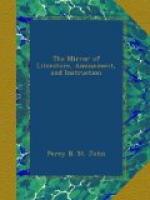“------that fresh features Have such a charm for us poor human creatures.”
Perhaps in this edifice, Eugenius, (the witty Duke of Wharton,[7]) and his boon companion, have sported their puns and repartees over the glass; whilst the laughter-moving Sterne, pursuing the dictates of his heart, has wet the dimpling cheek of Eugenius by some random effusion of imagination and sensibility. What two noble spirits have there displayed their intellectual brilliance; and what a gratification to have heard the author of “The Monk at Calais,” and “My uncle Toby,” eliciting smiles and tears by turns, till the delighted heart could scarcely determine whether joy or sorrow caused the most exquisite feeling.
But to conclude our peregrination—the glory of Hode, Rievaulx, and Byland abbeys has departed—their founders, ecclesiastics and patrons, have become dust—the crumbling arch and tottering pillar alone record “the whereabouts” of the rendezvous of heroes and kings—and rooks construct their dwellings where the silver crucifix once reared its massy form, before crowds of adoring monks—the hoarse croak of the raven is now heard through that valley where pealed the vesper bell; and the melancholy music of the lonely river succeeds the solemn chant of mass;—laugh and jest resound where monkish praise quivered through the Gothic space—the helmet and coronet of blood and birth are fallen from their wearers—and the genius and eccentricity of Sterne, and the wit of Wharton, are for ever extinct:
“And fortress, fane and wealthy
peer
Along the tide of time are borne.
And feudal strife, with noble tears
Forgotten in the lapse of years.”
[7] Of Skelton Castle, author
of “Crazy Tales,” and of the
“Continuation of Sterne’s
Sentimental Journey.”
H.
* * * * *
CROMLEH IN ANGLESEA.
[Illustration: Cromleh in Anglesea.]
Cromlehs are among the most interesting of all monumental relics of our ancestors; but the question of their original purposes has excited much controversy among the lovers of antiquarian lore. They are immense stones, by some believed to have been the altars, by others, the tombs, of the Druids; but Mr. Toland explains the word cromleac, or cromleh, from the Irish crom, to adore, and leac, a stone—stone of adoration. Crom was also one of the Irish names of God; hence cromleac may mean the stone of Crom, or of the Supreme God. The cromleac is also called Bothal, from the Irish word Both, a house, and al, or Allah, God; this is evidently the same with Bethel, or house of God, of the Hebrews.




